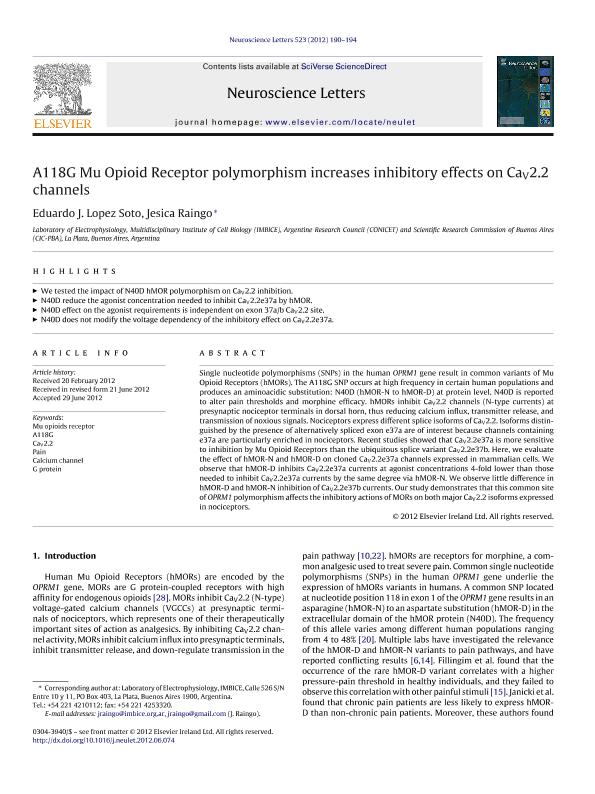Mostrar el registro sencillo del ítem
dc.contributor.author
López Soto, Eduardo Javier

dc.contributor.author
Raingo, Jesica

dc.date.available
2019-01-07T19:38:35Z
dc.date.issued
2012-06
dc.identifier.citation
López Soto, Eduardo Javier; Raingo, Jesica; A118G Mu Opioid Receptor polymorphism increases inhibitory effects on Ca V2.2 channels; Elsevier Ireland; Neuroscience Letters; 523; 2; 6-2012; 190-194
dc.identifier.issn
0304-3940
dc.identifier.uri
http://hdl.handle.net/11336/67609
dc.description.abstract
Single nucleotide polymorphisms (SNPs) in the human OPRM1 gene result in common variants of Mu Opioid Receptors (hMORs). The A118G SNP occurs at high frequency in certain human populations and produces an aminoacidic substitution: N40D (hMOR-N to hMOR-D) at protein level. N40D is reported to alter pain thresholds and morphine efficacy. hMORs inhibit Ca V2.2 channels (N-type currents) at presynaptic nociceptor terminals in dorsal horn, thus reducing calcium influx, transmitter release, and transmission of noxious signals. Nociceptors express different splice isoforms of Ca V2.2. Isoforms distinguished by the presence of alternatively spliced exon e37a are of interest because channels containing e37a are particularly enriched in nociceptors. Recent studies showed that Ca V2.2e37a is more sensitive to inhibition by Mu Opioid Receptors than the ubiquitous splice variant Ca V2.2e37b. Here, we evaluate the effect of hMOR-N and hMOR-D on cloned Ca V2.2e37a channels expressed in mammalian cells. We observe that hMOR-D inhibits Ca V2.2e37a currents at agonist concentrations 4-fold lower than those needed to inhibit Ca V2.2e37a currents by the same degree via hMOR-N. We observe little difference in hMOR-D and hMOR-N inhibition of Ca V2.2e37b currents. Our study demonstrates that this common site of OPRM1 polymorphism affects the inhibitory actions of MORs on both major Ca V2.2 isoforms expressed in nociceptors. © 2012 Elsevier Ireland Ltd.
dc.format
application/pdf
dc.language.iso
eng
dc.publisher
Elsevier Ireland

dc.rights
info:eu-repo/semantics/openAccess
dc.rights.uri
https://creativecommons.org/licenses/by-nc-sa/2.5/ar/
dc.subject
A118g
dc.subject
Ca V2.2
dc.subject
Calcium Channel
dc.subject
G Protein
dc.subject
Mu Opioids Receptor
dc.subject
Pain
dc.subject.classification
Neurociencias

dc.subject.classification
Medicina Básica

dc.subject.classification
CIENCIAS MÉDICAS Y DE LA SALUD

dc.title
A118G Mu Opioid Receptor polymorphism increases inhibitory effects on Ca V2.2 channels
dc.type
info:eu-repo/semantics/article
dc.type
info:ar-repo/semantics/artículo
dc.type
info:eu-repo/semantics/publishedVersion
dc.date.updated
2019-01-02T19:31:55Z
dc.journal.volume
523
dc.journal.number
2
dc.journal.pagination
190-194
dc.journal.pais
Irlanda

dc.journal.ciudad
Limerick
dc.description.fil
Fil: López Soto, Eduardo Javier. Consejo Nacional de Investigaciones Científicas y Técnicas. Centro Científico Tecnológico Conicet - La Plata. Instituto Multidisciplinario de Biología Celular. Provincia de Buenos Aires. Gobernación. Comisión de Investigaciones Científicas. Instituto Multidisciplinario de Biología Celular. Universidad Nacional de La Plata. Instituto Multidisciplinario de Biología Celular; Argentina
dc.description.fil
Fil: Raingo, Jesica. Consejo Nacional de Investigaciones Científicas y Técnicas. Centro Científico Tecnológico Conicet - La Plata. Instituto Multidisciplinario de Biología Celular. Provincia de Buenos Aires. Gobernación. Comisión de Investigaciones Científicas. Instituto Multidisciplinario de Biología Celular. Universidad Nacional de La Plata. Instituto Multidisciplinario de Biología Celular; Argentina
dc.journal.title
Neuroscience Letters

dc.relation.alternativeid
info:eu-repo/semantics/altIdentifier/doi/https://dx.doi.org/10.1016/j.neulet.2012.06.074
dc.relation.alternativeid
info:eu-repo/semantics/altIdentifier/url/https://linkinghub.elsevier.com/retrieve/pii/S0304394012009068
Archivos asociados
